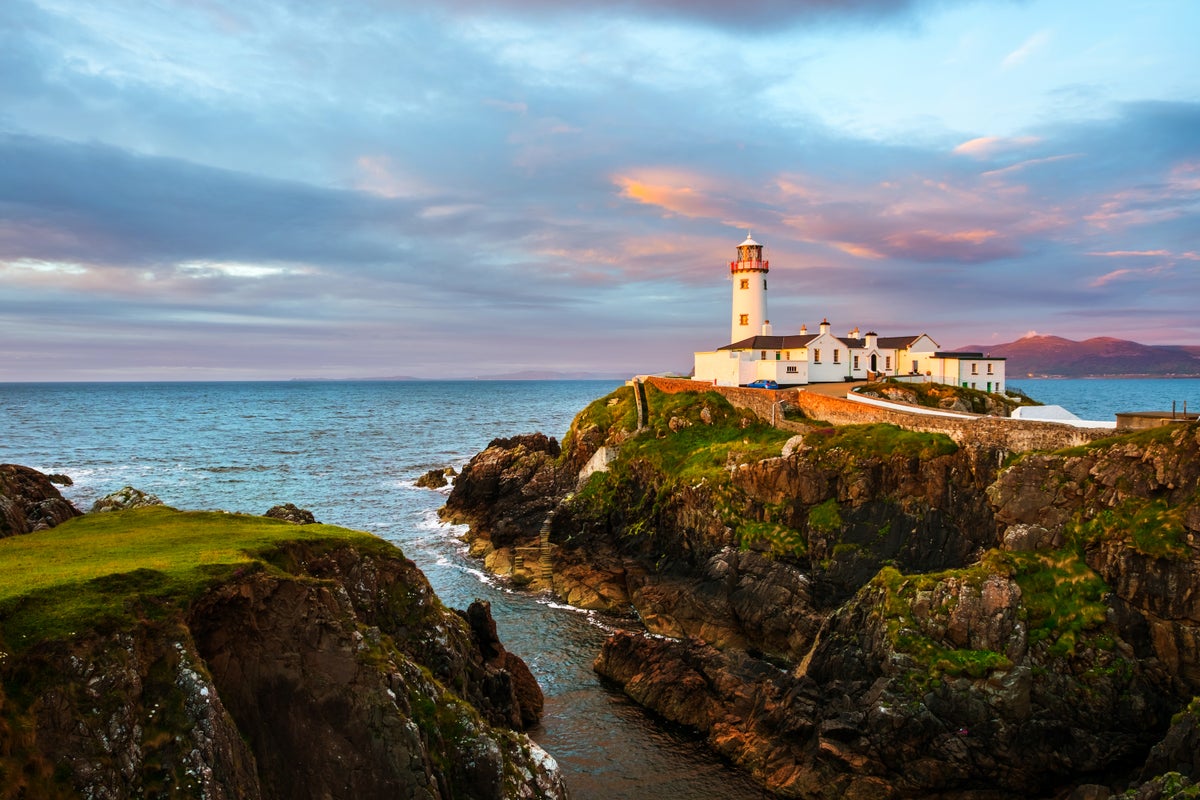
Start your day with one of the finest views in Donegal: 800ft up on Greenan Mountain, the location of the ancient hill fort known as Grianan of Aileach. The location has witnessed millennia of Ireland’s history. Archaeological evidence reveals human activity stretching back 3,700 years. The earliest people here worshipped Dagda, whose name translates as “the Good God”, at ancient gatherings.
In the fifth century of the Christian era, St Patrick is believed to have visited the site. A century or two later, the ring fort was built: a circle of stone with a parapet that provides 360-degree views of the glorious surroundings. During the Victorian age some reconstruction took place, which explains why the fort appears in good shape.
“It’s very humbling to think that we’re stood here at a place where the neolithic man would have been,” says Donegal tour guide Henry Doohan. County Donegal, he says, is special. “Some people call Donegal the forgotten county, the undiscovered county. There’s a quietness to it, and there’s a more simplistic view of life up here as well. Come up here and see the real Ireland.”
One of the best ways to see it is to take to the road: in this case the exciting hill-climbing, coast-hugging route along the west side of beautiful Lough Swilly, delivering one heavenly vista after another.
The shores of Ireland are etched with beaches that rival those in the Caribbean and Indian Ocean, yet without the crowds. Keep an eye open for Ballymastocker Beach – voted one of the most beautiful in the world.
The road reaches an inspiring conclusion at Fanad Head, commanding a majestic yet treacherous coastline. The landmark here is a handsome lighthouse born from a maritime tragedy involving Royal Navy ship HMS Saldanha. She was wrecked here in 1811, with the loss of more than 250 men. The lighthouse, designed to avert future calamities, was opened on Saint Patrick’s Day 1815. Today, it is part of a social enterprise in a largely Irish-speaking region. Besides touring the lighthouse, you can stay in the keepers’ cottages – providing the chance to enjoy the marine life that passes here, including basking sharks and dolphins.
To go one step beyond the far north western edge of Europe, take a ferry to Ireland’s most remote inhabited isle: Tory Island. The nine-mile journey from the coast of County Donegal takes around 45 minutes. The vessel doesn’t take cars; fortunately, Tory Isalnd resident Owen Clarke, offers e-bike exploration of this fragment of Ireland, which measures just 5km long and 1km across at its widest. Owen is also a photographer and videographer, and runs the local pub. “Tory’s one of those hidden secrets,” he says.
Donegal— (Shutterstock / Madrugada Verde)
The way that the elements have sculpted the island made it naturally enticing as a location for artists seeking inspiration amid glorious solitude.
In the 1950s, the noted British artist Derek Hill discovered Tory Island. He had a hut built so that he could live and paint on the raw edge of Europe.
Back on the mainland, you can visit Derek Hill’s Donegal home: Glebe House, where the artist lived when he wasn’t painting in his isolated hut. He was a former director of fine arts at the British School in Rome, and a painter of celebrities and royalty – but he found creative happiness in County Donegal. His home was given to the people of Ireland, and contains much art – with the kitchen on its own a tribute to the inspiration provided by Tory Island.
Aviation fans have repeatedly voted Donegal Airport as having the most beautiful approach in the world. As a result, the airport has become a tourist attraction in its own right with people popping in from the Wild Atlantic Way to have a cup of tea and watch the activity.
Architects have been busy elsewhere in County Donegal, designing “A modern retreat at the far edge of Ireland”. That’s the name for Breac House Boutique Bed and Breakfast. The house was designed by local architects and built by local tradespeople, with the invitation to guests to “take refuge and slow down” – in a calm space filled with natural materials from the surrounding area.
On the terrace just below the house is a sauna. The Scandinavians like to think that they came up with the concept of saunas. But locals claim they were predated by the traditional Irish sweathouse – of which this is a modern take, made only of stone and timber with a grass roof and a very impressive stove.
Heat and water are crucial for making Irish whiskey. Distilling in this part of the world has been dated back to 560 AD, when it is said St Colmcille began the practice at the foot of Errigal – the dominant mountain in the Seven Sisters chain. Today, numerous distilleries have perfected the art – including Crolly House. It was built from stone in 1901 as a carpet factory. For four decades in the 20th century, dolls were made here. But it is now a shrine to the liquid gold that warms the heart and lifts the soul.
Distillery manager Catherine Nic Griana: “Irish whiskey has to be the best whiskey there is,” she insists – adding “Whiskey is a healthy drink, like everything in moderation.”
A new visitor centre completes the experience. At the end of your tour, you can bottle your own 59.82% cask strength bottle of Irish whiskey, including one signed by actor Pierce Brosnan. Slainte.
Best of the northwest – along Ireland’s Wild Atlantic Way
Find out more about the Wild Atlantic Way and the unique adventures it offers, and start planning your own Ireland escape.
Thanks to the Common Travel Area, British visitors do not need a passport or a visa to travel to the island of Ireland (though check with your travel provider for any ID requirements).







